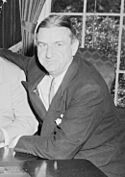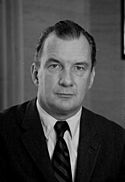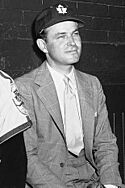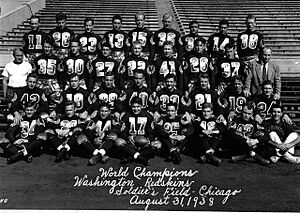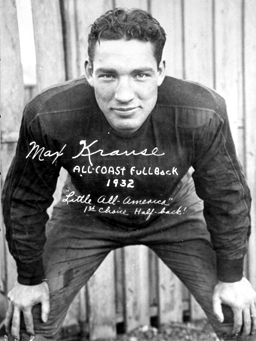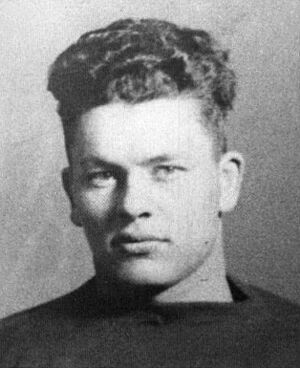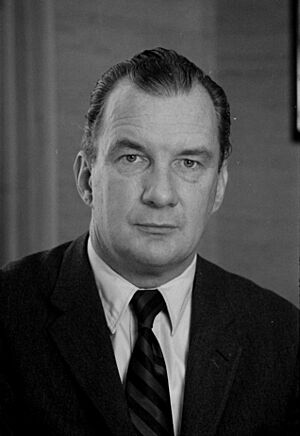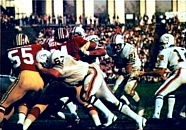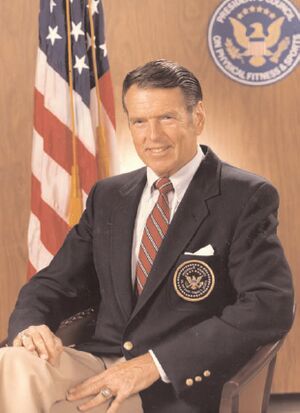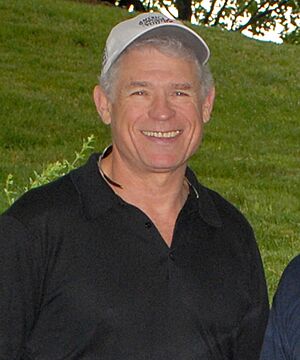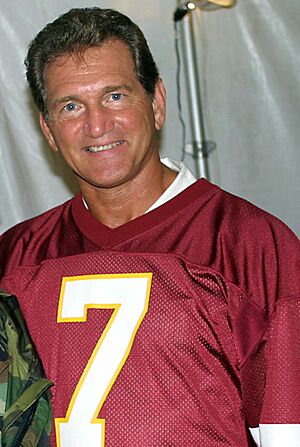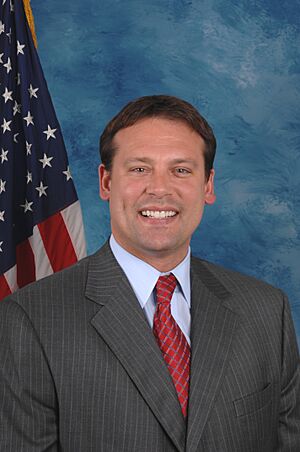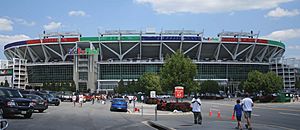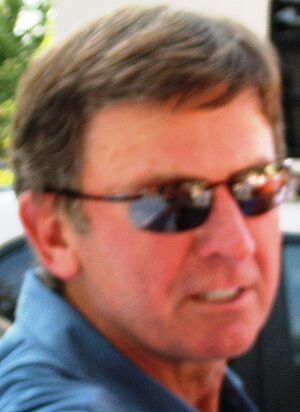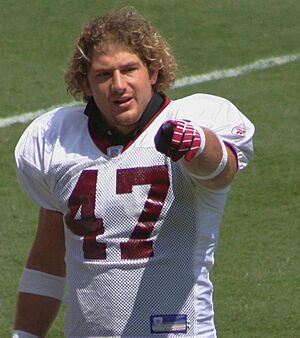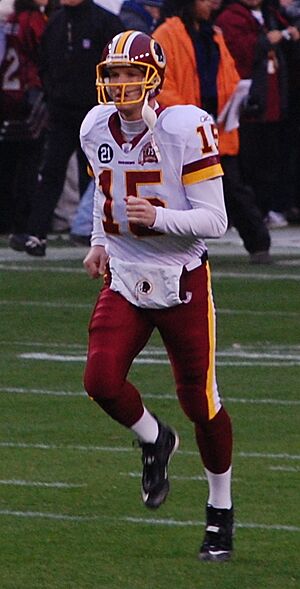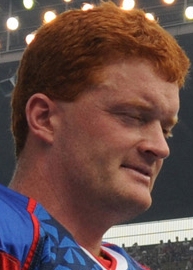History of the Washington Commanders facts for kids
The Washington Commanders are a professional American football team from the Washington metropolitan area. They play in the National Football League (NFL) as part of the East division in the National Football Conference (NFC). The team started in Boston in 1932 as the Boston Braves, named after the city's baseball team. The next year, they changed their name to the Redskins and moved to Washington, D.C. in 1937. In 2020, the team changed its name to the Washington Football Team due to discussions about the old name. In 2022, they became the Washington Commanders.
The Commanders have won three Super Bowl championships: Super Bowl XVII, Super Bowl XXII, and Super Bowl XXVI. They also played in and lost two other Super Bowls. Before the AFL and NFL joined together in 1970, Washington won two NFL Championships in 1937 and 1942. They also played in and lost four other championship games. Only a few teams have played in more Super Bowls than Washington.
The team's championships happened during two successful periods. The first was from 1936 to 1945, when they reached the NFL Championship six times and won two. The second was from 1982 to 1991, when they made the playoffs seven times, won four Conference titles, and earned three Super Bowls. This included the 1983 and 1991 seasons, where they won 14 games, their most ever in a single season.
Washington has also had tough times. From 1946 to 1970, they had only four winning seasons and no playoff games. They went from 1956 to 1968 without a single winning season. Their worst record was 1–12–1 in 1961. The team is currently in another tough period, which began in 1993. Since then, they have had only eight winning seasons and six playoff appearances.
Contents
Early Years in Boston (1932–1936)
The NFL gave a team to Boston on July 9, 1932. It was owned by George Preston Marshall and others. The team was first called the Boston Braves, like the local baseball team. They played their first game on October 2, 1932, and lost. The next week, they won their first game against the New York Giants. After the first season, Marshall became the only owner.
The team moved to Fenway Park in 1933 and changed its name to the "Redskins." The team said the name honored their coach, Lone Star Dietz, who was believed to be part Sioux. However, Marshall also said he wanted to avoid confusion with the baseball Braves.
In 1933, Cliff Battles made history by rushing for over 200 yards in a single game. The team had a few coaching changes over the next few years.
A Winning Season in Boston (1936)

The Redskins had their best year in Boston in 1936. They picked Riley Smith in the first-ever NFL draft. He was the first drafted player to play in the NFL. They also hired Ray Flaherty as head coach, who would lead them to many wins.
The team finished the season with a 7–5 record, their first winning season. They also won their first Eastern Division Championship. However, few fans came to their last home game. Because of this, owner Marshall decided to move the championship game to New York. They lost the 1936 NFL Championship Game to the Green Bay Packers.
After the 1936 season, the Redskins made a big addition: quarterback Sammy Baugh. He was known for his amazing passing skills, which was rare at the time. Baugh also played other positions like cornerback and punter.
Moving to Washington, D.C. (1937–1945)
On February 13, 1937, George Preston Marshall moved the team to his hometown of Washington, D.C.. They kept the name "Redskins" and shared Griffith Stadium with the Washington Senators baseball team.
Marshall wanted to make games exciting, like college football. He started the Redskins marching band on August 9, 1937. They are one of only two NFL teams with an official marching band. The team also got a fight song, "Hail to the Redskins," in 1938.
First Championship in D.C. (1937)
The Redskins won their first game in Washington, D.C., on September 16, 1937. They beat the Giants 13–3. On December 5, 1937, they won their first division title in Washington. A week later, on December 12, 1937, they won their first NFL Championship against the Chicago Bears. This was their first season in D.C.!
In 1938, the Redskins finished second in their division. In 1939, Frank Filchock threw the first 99-yard touchdown pass in NFL history. This record can only be tied, not broken.
The 73–0 Game (1940)
In 1940, the Redskins won nine games and topped their division. They met the Bears again in the 1940 NFL Championship Game. The Bears crushed the Redskins 73–0. This is still the most lopsided score in NFL history.
World War II Era (1941–1944)
The 1941 season ended on December 7, 1941, the day of the Attack on Pearl Harbor. This event brought the United States into World War II. Two popular Redskins players, Frankie Filchock and Wayne Millner, joined the U.S. Navy.
The Redskins and Bears met again in the NFL Championship. In 1942, Washington won their second championship, 14–6, against the previously undefeated Bears. In 1943, the Bears won the championship game 41–21. That year, Sammy Baugh led the NFL in passing, punting, and interceptions.
The "Baugh/Marshall Rule" (1945)
The Redskins played in one more NFL Championship before a long break. In 1945, they went 8–2. Sammy Baugh had an amazing completion percentage of .703. They lost the 1945 NFL Championship Game to the Cleveland Rams 15–14.
The one-point loss was controversial because of a safety early in the game. Sammy Baugh's pass hit the goal post, which was on the goal line back then. This was ruled a safety, giving the Rams a 2–0 lead. This safety was the difference in the game. Owner Marshall was so upset that he helped change the rule. Now, a forward pass that hits the goal posts is automatically incomplete. This is known as the "Baugh/Marshall Rule."
Challenges and Changes (1946–1970)
After 1945, the team struggled for many years. In 1950, the American Oil Company televised all Redskins games. This made Washington the first NFL team to have all its games on TV.
In 1952, Marshall hired Curly Lambeau, a famous coach. But after two seasons, Marshall fired him. In 1955, the Redskins had their first winning season in ten years.
In 1961, the Redskins moved to their new stadium, D.C. Stadium (later Robert F. Kennedy Memorial Stadium). They lost their first game there. The team struggled through the 1960s, but they drafted future stars like Charley Taylor and Chris Hanburger. They also traded for quarterback Sonny Jurgensen and linebacker Sam Huff.
The George Allen Era (1971–1977)
In 1965, owner George Preston Marshall became very ill. He asked Edward Bennett Williams to run the team. After Marshall died in 1969, Williams bought the team. In 1969, Williams hired legendary coach Vince Lombardi. Lombardi led the Redskins to their first winning season since 1955. Sadly, Lombardi died of cancer before the 1970 season.
The "Over-the-Hill Gang" (1971–1977)
In 1971, Williams hired George Allen as head coach. Allen liked experienced players, and his teams were called the "Over-the-Hill Gang." His motto was "The future is now."
Allen led the Redskins to the playoffs for the first time since 1945. They lost in the Divisional Playoffs.
Super Bowl VII Appearance (1972)
In 1972, the Redskins won their division. They beat the Green Bay Packers and the Dallas Cowboys in the playoffs. This led them to Super Bowl VII, where they played the undefeated Miami Dolphins. The Dolphins won 14–7.
The Redskins continued to make the playoffs in 1973 and 1974 but lost in the Divisional Playoffs both times. In 1975, Sonny Jurgensen retired. The team missed the playoffs that year. In 1976, they made the playoffs again but lost. George Allen was fired after the 1977 season.
Jack Kent Cooke Takes Over (1979–1999)
Jack Kent Cooke became the team's main owner in 1979. In 1979, the Redskins had a great season, finishing 10–6. They almost made the playoffs but lost a close game to Dallas. Coach Jack Pardee was named Coach of the Year.
The Joe Gibbs Era Begins (1981)

On January 13, 1981, Jack Kent Cooke hired Joe Gibbs as head coach. Gibbs brought in new players like Mark May, Russ Grimm, and Dexter Manley. After a tough start, the team finished the 1981 season with an 8–8 record.
Super Bowl XVII Champions (1982)
The 1982 season was shortened by a players' strike. The NFL held a special playoff tournament. The Redskins played very well after the strike, winning six of seven games. They made the playoffs for the first time since 1976. Kicker Mark Moseley set an NFL record with 21 consecutive field goals.
The Redskins had a famous offensive line called "The Hogs." They were known for being tough and strong. Players like Jeff Bostic, Russ Grimm, and Joe Jacoby were key members. The team also had a group of receivers called the "Fun Bunch," known for their touchdown celebrations. These celebrations later led to a league-wide ban on "excessive celebration."
In the playoffs, the Redskins beat the Minnesota Vikings and the Dallas Cowboys. They won their first Super Bowl, Super Bowl XVII, on January 30, 1983, defeating the Miami Dolphins 27–17. Running back John Riggins had a famous 43-yard touchdown run that sealed the win.
Super Bowl XVIII Appearance (1983)
The 1983 season started with a close loss to the Dallas Cowboys. Rookie Darrell Green joined the team that year. The Redskins had an amazing season, winning 14 games. They scored an NFL record 541 points, with John Riggins scoring 24 touchdowns.
In the playoffs, they beat the Los Angeles Rams and the San Francisco 49ers. However, they lost Super Bowl XVIII to the Los Angeles Raiders 38–9.
Injuries and Setbacks (1984–1985)
In 1984, the Redskins won their division again but lost in the playoffs. The 1985 season was tough. Quarterback Joe Theismann suffered a severe leg injury during a game and had to retire. The team finished 10–6 and missed the playoffs.
Super Bowl XXII Champions (1987)
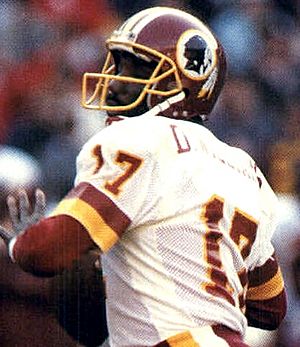
The 1987 season was affected by a players' strike. The Redskins won three games with replacement players. These wins helped them make the playoffs. The team went on to win their second championship in Super Bowl XXII on January 31, 1988. They defeated the Denver Broncos 42–10. Quarterback Doug Williams had an incredible performance, throwing four touchdowns in the second quarter. He became the first African-American quarterback to win a Super Bowl. Rookie running back Timmy Smith also set a Super Bowl record with 204 rushing yards.
Return to the Playoffs (1988–1990)
The Redskins missed the playoffs in 1988 and 1989. In 1989, Gerald Riggs set a team record with 221 rushing yards in a single game. In 1990, the Redskins returned to the playoffs but lost to the 49ers.
Super Bowl XXVI Champions (1991)

The 1991 season started with a team record of 11 straight victories. The "Hogs" offensive line allowed very few sacks. The Redskins finished with a 14–2 record and dominated the playoffs. On January 26, 1992, they won Super Bowl XXVI by defeating the Buffalo Bills 37–24. Eight Redskins players were chosen for the Pro Bowl after this season. The wide receiver trio known as the "Posse" (Art Monk, Gary Clark, and Ricky Sanders) played a huge role.
In 1992, the Redskins made the playoffs again but lost. On October 12, 1992, Art Monk became the NFL's all-time leading pass receiver. Joe Gibbs retired from coaching on March 5, 1993.
New Coaches and Stadium (1993–1999)
After Gibbs left, the Redskins hired former player Richie Petitbon as coach in 1993. The team had a tough year, finishing 4–12. Petitbon was fired, and Norv Turner was hired in 1994.
Turner's first two years were not great. In 1994, Monte Coleman broke the team record for most games played. Many key players left the team due to salary cap issues.
On March 13, 1996, the team began building a new stadium. The 1996 season was better, but they still missed the playoffs. On December 16, 1996, the Redskins played their last game at Robert F. Kennedy Memorial Stadium. They won against the Dallas Cowboys. Terry Allen also set a new team rushing record that year.
On April 6, 1997, owner Jack Kent Cooke passed away. His son, John Kent Cooke, announced the new stadium would be named Jack Kent Cooke Stadium. On September 14, 1997, the Redskins played their first game in the new stadium and won. In 1998, the team had a losing record. Brian Mitchell led the NFL in total yards for the fourth time.
The Daniel Snyder Era (1999–2023)
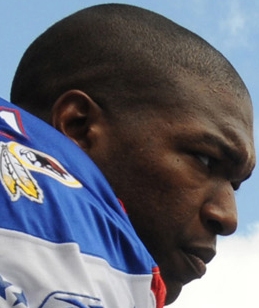
In 1999, John Kent Cooke sold the team to Daniel Snyder for $800 million. This was the most expensive team sale in sports history at the time. Snyder quickly sold the naming rights to the stadium, and it became FedExField.
In Snyder's first season, the Redskins went 10–6 and made the playoffs for the first time since 1992. They won their first NFC East title since 1991. Running back Stephen Davis set a new rushing record for the club. They won their first playoff game but lost a close game to the Tampa Bay Buccaneers.
Coaching Changes (2000–2003)
In 2000, the Redskins drafted future Pro Bowlers LaVar Arrington and Chris Samuels. Coach Norv Turner was fired during the season. The team finished 8–8.
In 2001, Marty Schottenheimer became the new coach. The season started with a loss. After the September 11 attacks, the Redskins created a relief fund to help victims' families. The team raised over $700,000. Stephen Davis became the first Redskin to rush for over 1,000 yards for three seasons in a row.
In 2002, Steve Spurrier became the coach. The team finished with a losing record. On December 29, 2002, Darrell Green played his 20th and final season. He set an NFL record for consecutive seasons with at least one interception.
The 2003 season started with a big NFL kickoff game at FedExField. The Redskins won, but they finished the season with a 5–11 record, their worst since 1994. Defensive end Bruce Smith broke the NFL's all-time sack record. Spurrier resigned after two seasons.
Joe Gibbs Returns (2004–2007)
In 2004, Daniel Snyder convinced Joe Gibbs to return as head coach. Snyder also made FedExField bigger, with over 91,000 seats. The Redskins traded for running back Clinton Portis.
Gibbs' first game back was a win, the 500th regular season win in franchise history. However, the team finished 6–10. They drafted talented players like Sean Taylor and Chris Cooley.
In 2005, the Redskins traded for wide receiver Santana Moss. They also drafted quarterback Jason Campbell. The team started strong, including a famous comeback win against the Dallas Cowboys on Monday Night Football. They won five straight games at the end of the season to make the playoffs. They beat the Tampa Bay Buccaneers but lost to the Seattle Seahawks.
Three team records were broken in 2005: Clinton Portis rushed for 1,516 yards, Santana Moss had 1,483 receiving yards, and Chris Cooley had 71 receptions.
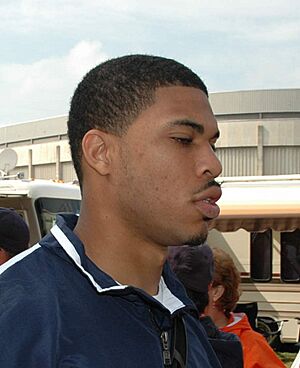
The 2006 season was disappointing. The team signed several expensive players, but they struggled. They finished 5–11.
Tragedy and Resilience (2007)
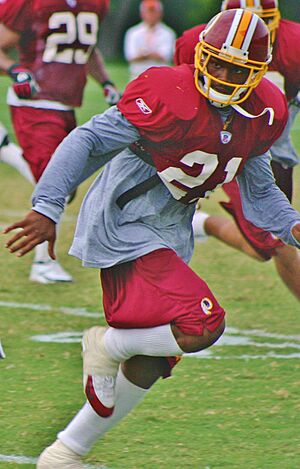
The 2007 season was very emotional. The team started 5–3. Then, on November 27, safety Sean Taylor tragically passed away. The NFL honored Taylor with a black #21 sticker on helmets. The Redskins painted his number on the field and created a trust fund for his daughter.
Just five days after Taylor's death, the Redskins played the Buffalo Bills. The team honored Taylor by starting with only ten players on defense. They lost the game in a close finish. The entire Redskins organization flew to Florida for Taylor's funeral.
Despite the tragedy, the team rallied. Backup quarterback Todd Collins led them to four straight wins. They finished 9–7 and earned a Wild Card spot in the playoffs. They secured their playoff spot with a 27–6 win over the Dallas Cowboys.
The Redskins lost in the Wild Card round to the Seahawks. Three players, Chris Cooley, Chris Samuels, and Ethan Albright, were named to the 2008 Pro Bowl. They all wore #21 to honor Sean Taylor. Taylor was also posthumously elected to the Pro Bowl.
New Coaches and Players (2008–2009)
On January 7, 2008, Joe Gibbs retired again. Jim Zorn was hired as the new head coach. In 2008, former players Darrell Green and Art Monk were voted into the Pro Football Hall of Fame.
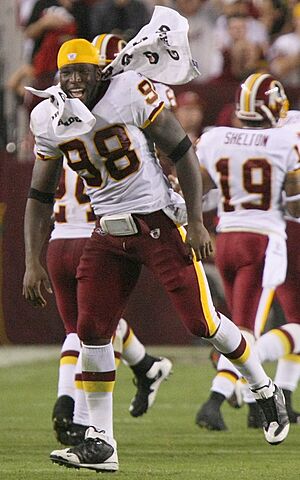
In 2009, the Redskins signed defensive tackle Albert Haynesworth and cornerback DeAngelo Hall. They also drafted defensive end Brian Orakpo, who became a Pro Bowler in his rookie season. The team struggled, finishing 4–12. Jim Zorn was fired after the season.
The Mike Shanahan Era (2010–2013)
On January 5, 2010, Mike Shanahan became the new head coach. He brought his son, Kyle Shanahan, as offensive coordinator. The team changed its defense from a 4–3 to a 3–4 scheme.
The team acquired quarterback Donovan McNabb from the Philadelphia Eagles. They also drafted offensive tackle Trent Williams. In their season opener, they beat the Dallas Cowboys. DeAngelo Hall tied a team record with 4 interceptions in one game. The Redskins finished 6–10.
In 2011, the Redskins released several veteran players. They drafted defensive end Ryan Kerrigan, who became a key pass rusher. The team finished 5–11.
Division Title (2012)
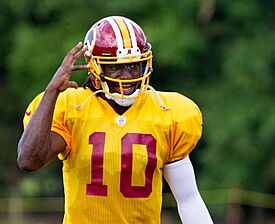
In 2012, the Redskins traded many draft picks to get the second overall pick. They used it to draft quarterback Robert Griffin III. He had an amazing rookie season, throwing for 3,200 yards and 20 touchdowns. He also rushed for 815 yards and 7 touchdowns. Griffin III won the NFL Offensive Rookie of the Year award.
The Redskins signed wide receivers Pierre Garçon and Josh Morgan. Running back Alfred Morris was drafted in the sixth round. He had an impressive rookie season, rushing for a team record 1,613 yards.
The Redskins won their last seven games of the season to win their division title. This included a big win against the Dallas Cowboys on Thanksgiving Day. In the final game of the season, they beat the Cowboys again to win the NFC East.
In the playoffs, the Redskins faced the Seattle Seahawks. Robert Griffin III injured his knee during the game. The Redskins lost 24–14. Griffin III had surgery on his knee but vowed to return stronger. The team moved its summer training camp to Richmond, Virginia.
Tough Season (2013)
Hopes were high for 2013, but the team had a very tough year, finishing 3–13. This was their worst record since 1994. Pierre Garçon broke Art Monk's franchise record for catches in a single season with 113. Mike Shanahan was fired after the season.
The Jay Gruden Era (2014–2019)
On January 9, 2014, Jay Gruden was hired as head coach. The team struggled, finishing 4–12. Owner Daniel Snyder also shared his desire to build a new stadium for the team.
In 2015, the Redskins hired Scot McCloughan as general manager. On October 25, 2015, the Redskins had their biggest comeback win ever, overcoming a 24-point deficit to beat the Tampa Bay Buccaneers.
The Redskins won the NFC East division title in 2015. They hosted the Green Bay Packers in the playoffs but lost. Quarterback Kirk Cousins had a great season, setting career highs in touchdowns and passing yards.
In 2016, the team's offense set several franchise records. Kirk Cousins also set new team records for passing attempts, completions, and yards. Despite this, the Redskins missed the playoffs. Their defense struggled, leading to coaching changes.
In 2017, Kirk Cousins played under the franchise tag and threw for over 4,000 yards. The team finished 7–9 and missed the playoffs. Cousins left the team after the season.
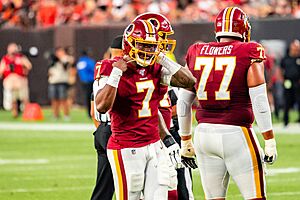
In 2018, the Redskins traded for quarterback Alex Smith. The team started 6–3, but Smith broke his leg in Week 11, ending his season. The team struggled after that, finishing 7–9. Many players were injured that season.
In 2019, the Redskins drafted Dwayne Haskins. The team started 0–5. On October 7, 2019, Jay Gruden was fired. Bill Callahan became the interim head coach. The team finished 3–13. Challenges within the team's management were reported. After the season, team president Bruce Allen was fired.
Team Rebranding and New Ownership (2020–Present)

In 2020, the team made big changes. They retired the Redskins name and logo. They hired Ron Rivera as head coach and Jason Wright as team president, the first black person in that role in NFL history. The team also changed its defensive scheme. They drafted Chase Young, who was named Defensive Rookie of the Year. Despite a tough start, Washington won their division with a 7–9 record.
In 2021, the team hired Martin Mayhew as general manager. Washington became the first NFL team to have a minority general manager, head coach, and president at the same time. Ryan Kerrigan, the team's all-time sack leader, left to play for the Philadelphia Eagles.
The team rebranded as the Commanders in 2022. Their fight song, "Hail to the Commanders," returned with new lyrics. Their cheerleading squad was replaced by a co-ed performance group. The team traded for quarterback Carson Wentz, but he was released after one season.
New Ownership (2023–Present)
In May 2023, Daniel Snyder reached an agreement to sell the team to an investment group led by Josh Harris. The sale was for $6.05 billion, the largest for any sports team at the time. The group includes many investors, such as NBA Hall of Famer Magic Johnson. The sale was approved by the NFL owners on July 20, 2023.


